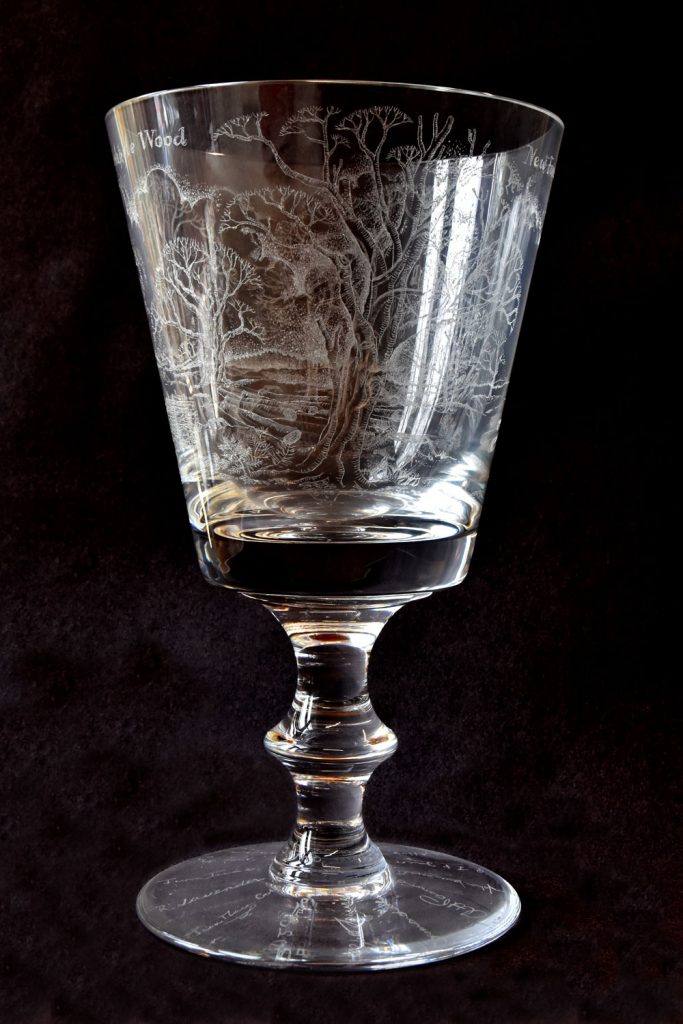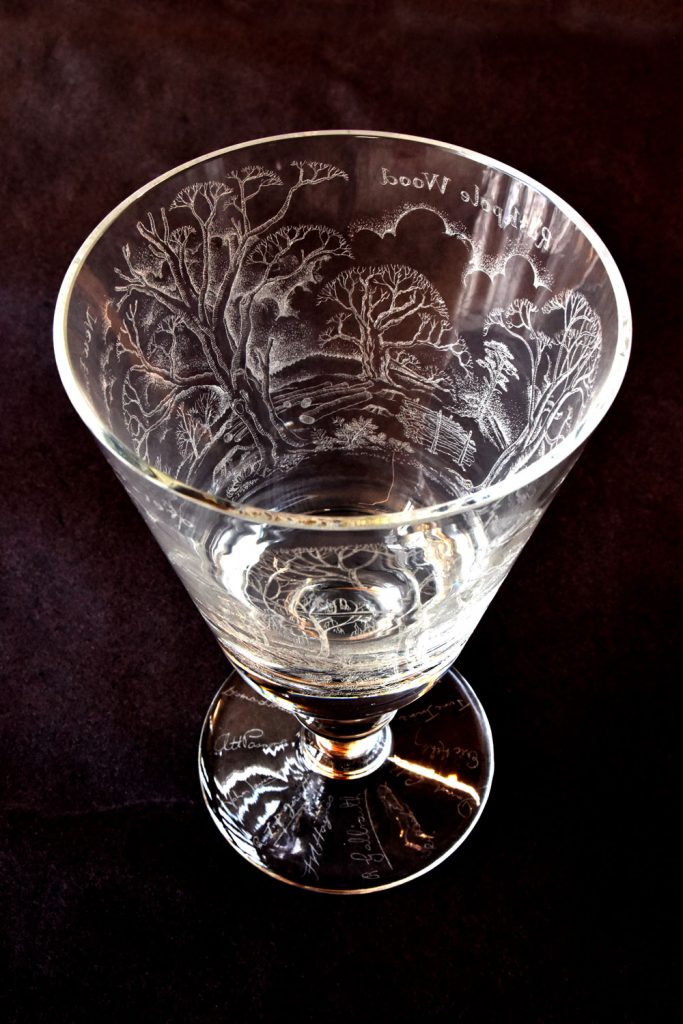Rushpole Wood goblet


This fine goblet is in the New Forest Museum and can be found on display in the museum’s Upper Gallery. It was engraved to commemorate the remarkable success of a protest in 1970 against widespread and ruthless tree-felling by the Forestry Commission.
The background
The New Forest’s rich variety of trees is a mix of those found in Inclosures and those in the open forest. The latter is made up of heath, bog and lawn, together with the natural woodlands of oak, beech, chestnut, silver birch, holly and scrub. Those in the open forest were called ‘Ancient and Ornamental Woodlands’ in an act of 1877, which included that they ‘shall be preserved’. In 1964 the New Forest Act allowed the Forestry Commission to carry out ‘all such silvicultural maintenance works as may from time to time be necessary’. Within years of this act being passed, the then New Forest management felt justified in allowing the felling, or ‘thinning’ of Ancient and Ornamental woodland. By 1970, just six years since the act, it was estimated that over 1000 acres of A&O woodland had been felled in the New Forest. It was widely acknowledged that the felling was for the purpose of commercial exploitation. The names of purchasers of the wood were painted on the ends of stacked trunks, for example the Ercol wood furniture factory. In 1969 alone, over 1400 mature oak and beech trees from Rushpole Wood near Lyndhurst were felled, with their visibly obvious stubby tree stumps looking like a graveyard for the beautiful trees that once stood there.
The protest
The resulting and obvious devastation caused an outcry, with high emotion from many. It was soon apparent to Jean Cobb, who had lived in the forest since 1954, that something must be done. Jean was a staunch supporter and passionate campaigner of many things, not least the preservation and conservation of the New Forest. At the same time, there were other unsettling events taking place. A new Deputy Surveyor for the New Forest (the title given to the head of the Forestry Commission) was appointed, followed by the creation of a secret ‘Working Plan for the New Forest’. There was also the proposed merging of the New Forest with the Forestry Commission’s South-East Conservancy Area, to incorporate it with the rest of Hampshire, all of Surrey, Sussex, Berkshire and Kent. All of these disturbing events spurred Jean and eleven others into forming an action group, who raised a petition of protest, gaining more than 7500 signatures. This resulted in a public meeting on 14th February 1970 at the Verderers’ Court in Lyndhurst, with four members of the action group in attendance, led by Jean. The object of the meeting was to protest, not only against the creeping destruction of the Forest, but the fact that it was for commercial gain. Following the meeting, on 5th March 1970 the four members produced a brochure called ‘Destruction of the Environment in the New Forest’. Despite supportive reactions from naturalists, broadcasters, writers, scientists, artists and officers of the Hampshire Field Club, the felling continued. Eventually, as public indignation rose, on 10th September 1970 the Forestry Commission announced their intention of setting up a ‘New Forest Consultative Panel’ (still in existence today and see note at the foot of this article). Within days of the creation of the panel, Jean and the action group were able to obtain a leaked copy of the Working Plan for the New Forest relevant to the timber cropping programme. Its intent was devastating, proposing to clear swathes of trees from the open forest and in Inclosures, reduce oak, beech and other hardwoods to only four per cent.
The result
At the next Verderer’s Court in September 1970, Jean made a presentment on behalf of the action group, publicly disclosing the implications of the Working Plan on timber felling in the New Forest. With this being in breach of the 1877 act stating that the Ancient and Ornamental woodlands shall be preserved, the matter was taken to the then Minister of Agriculture, James Prior. On 22nd September 1970, Mr Prior banned all hardwood felling in the New Forest.
The Rushpole Goblet
The goblet is a Val St Lambert Glass State-Goblet, standing nearly 27cm high and 15cm in diameter.
Jean Main was born in Scotland in 1916 into a naval family, so her early life was often on the move. She was crippled through polio as a very young child and remembered learning to walk at the age of 6. Influenced by her grandfather who taught her to be sure in her line drawing, and with no formal training, Jean was spotted by the eminent artists Eric Gill (famous for his creation of the Gill Sans font) and the sculptor Bainbridge Copnall. Through them, Jean did commissions in glass in Leicester Square’s Odeon cinema, in stone at the Adelphi theatre in the Strand and decorated the public state-rooms of the pre-war Cunard liner the Queen Elizabeth with her wood carvings. She did not specialise in any particular art form and as well as her engravings, Jean painted. Owls and flowers were favourite subjects and in later years, pen and ink illustrations of the New Forest headed up each chapter of the book Verderers of the New Forest, written by Anthony Passmore. In 1979 the Verderers chose Jean to engrave a chalice (see above photo), which was presented to the Queen and Prince Philip to mark the 900th anniversary of the New Forest. Back in 1947 she met and married David Cobb, a naval reservist. He also had an ability to draw and after a distinguished Naval career, later became a celebrated marine artist. Their married life began on an old cutter called White Heather, moored alongside the Old Quay at Newlyn. In 1954, having given birth to a daughter, Jean decided life afloat was impractical. Knowing the New Forest from old and always wanting to live there, Jean chose to make their home in Setley, south of Brockenhurst. She and David built a small wooden home from the skeleton of a Colt house, with the assistance of a carpenter friend who came up from Newlyn to help them. Jean worked from a studio situated on the upper floor of the home, whilst also tirelessly campaigning for various causes and she frequently rescued injured or orphaned owls. In 1956 Jean helped Hungarian refugees and in 1960 she helped set up the Hampshire and Isle of Wight Naturalist Trust. As well as the Rushpole Wood protest, Jean took it upon herself to become fully versed in the acts of Parliament that protected the New Forest. Another of her victories was the evidence she presented at the Government’s public enquiry into Shell UK’s planning application to drill for oil in Denny Inclosure, which led to the plans being abandoned. From David’s own tribute to his wife Jean following her death, ‘she always hoped to end her life in her cottage, surrounded by all the dumb, defenceless species whom she loved and sought to protect, who (when they could) actively returned her love. On 7th April 1998 this wish was granted. If ever there was a life to celebrate rather than to mourn, this was it. It is just a pity there are not more people like her’.
Footnote
The Rushpole Goblet, the events surrounding the protest that it commemorates, and the dogged determination of Jean Cobb are hugely significant. The following link takes you to the House of Lords debate about the creation of the New Forest Consultative Panel, taken from Lords Hansard (a substantially verbatim report of what is said in the House of Lords each day), dated 3rd November 1970
https://api.parliament.uk/historic-hansard/lords/1970/nov/03/new-forest-consultative-panel
Concerns about many different aspects are raised over 50 years ago about the New Forest, most of which are still relevant today.
Details of the consultative panel in its present-day format: https://www.newforestnpa.gov.uk/about-us/forums-and-facilities/consultative-panel/

